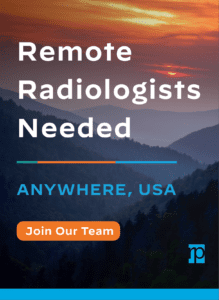A Q&A with RP Co-founders, Rich Whitney and Dr. Anthony Gabriel
Radiology Partners (RP) was founded in 2012 with a bold mission to Transform Radiology. A decade later, RP is a leading radiology practice in the nation and a clear leader in our specialty. Our momentum is driven by our people—the best radiologists, support teammates and leaders working together to provide the best clinical value and service. Our people are driven by our culture, which is centered around our values: integrity, teamwork, excellence, service and accountability. As the practice celebrates 10 years of Transforming Radiology, we sat down with RP co-founders, Rich Whitney, Chairman and CEO, and Dr. Anthony Gabriel, President and Chief Operating Officer, to hear their perspectives on the milestones RP has reached thus far and the practice’s momentum for the future.
Why was Radiology Partners founded?
RW: From the start, the core idea was that radiology and imaging had become so critical to how healthcare was delivered in the U.S., and we felt like radiology was in a fulcrum position to have a big impact on downstream healthcare and on patient outcomes.
AG: When we started in 2012, a lot of things had changed in the prior decade. First, the introduction and advancement of picture archiving and communication systems (PACs) allowed for more technology-enabled radiology. Second, there was a growing need for subspecialty radiologists, and practices needed to offer all the subspecialties in a single group. Finally, imaging was increasingly important as a real-time diagnostic tool—24/7 radiology was critically important, particularly for emergency physicians. These factors meant a typical radiology group would need to be technology-enabled, big enough to offer subspecialists and provide 24/7 service. Yet, the median size of a radiology group at the time was nine doctors. We knew that wouldn’t be sustainable for where the specialty was headed and that groups would need to grow.
Then we asked ourselves, ‘Why hasn’t somebody else thought of this?’ We spent months asking people that question—healthcare experts, hospital leaders and radiologists. What we learned was that it had been tried but in many instances those attempts didn’t include radiologist leaders. We knew we had to have radiologists in leadership roles to be successful. That was our big thing—putting radiologists in the driver’s seat.
RW: Having spent virtually my entire career in healthcare services, in some ways I couldn’t believe there was this important segment of healthcare that found itself in such an important position. Yet there hadn’t been anyone who successfully built something of scale, and it hadn’t attracted a lot of investment capital to drive innovation in the field. Radiology is not a sideline specialty. It is at the center of the continuum of care, and we felt that if we could create big step function change in radiology, we could have a big impact not only on this field but, in turn, on the rest of the healthcare field overall.
How did you develop the vision for RP and convince radiologists to join you?
RW: Everything we’ve accomplished as RP we owe to the people who are attracted to the idea of transforming radiology. We attracted a lot of partners in those early days and continued to attract great physicians and great leaders who made the last 10 years possible. When I think about milestones, I will never forget meeting Dr. Nina Kottler, who we affectionately call Rad One because she was the first radiologist to join RP. When you meet her, you know she’s special. Her passion, her intellect and the things she cares about are unique. Anthony and I quickly we realized we needed her in our orbit. She had the foresight and the courage to join a radiology practice that had no radiology to do at the time. Today, we account for nearly 50 million exams per year.
AG: We had no radiologists, we had no clients, and we had no exams. It was just a couple of guys with an idea. I’m not even sure we had an office yet. I think we were still working out of my house. I told Nina that and she said, ‘Well, when do you expect to have some stuff for me to do?’ We gave her an estimate, which turned out to be true, but in the beginning she was working part-time helping us brainstorm and create RP. She helped us think about our technology platform from the very beginning. She also helped us recruit practices to join us.
Radiologist leadership was central from the very beginning. What is your approach to physician leadership?
AG: Radiologist leadership has had a huge impact on our practice from day one and still does today. We have an extraordinarily impressive team of physician executives within our practice. I compare it to hospitals and health systems I visit, and it’s common to see a physician responsible for physician groups and leading something like clinical quality. We definitely have doctors who focus on our clinical practices and programs, but what sets us apart is that we have physicians leading and driving other areas of the business, like government relations, growth, recruiting operations and more. They’re doing more than ‘doctor stuff,’ so to speak; they’re driving the business and the overall organization.
RW: As we set out to build a large-scale physician practice, we recognized we needed 10s and ultimately 100s of highly-capable physician leaders. Most physicians are not specifically trained in leadership, and many don’t have leadership experience. Physicians are certainly capable of leading—they just haven’t had the opportunity.
Early on, we built RP University to offer physicians both technical and didactic leadership development. Beyond RP University, we offer opportunities to exercise leadership skills by having lots of physician leaders instilled within our practice—the Office of the Chief Medical Officer, our Clinical Value team and Physician Support Boards are just a few examples. Today, we have more than 100 physician leaders who are actively helping to lead this practice. That’s one of the distinguishing characteristics of RP. We have said for many years that if we can be an example in the healthcare system of how to develop great physician leaders—be best-in-class in that regard—then physician leadership will be one of our most important competitive advantages and perhaps we will encourage other healthcare organizations to keep physicians in the driver’s seat as they scale.
RP is also focused on bringing the best and brightest support teammates to the practice. Why are support teammates important to the mission?
RW: There is a long list of accomplishments from our first decade as a practice that can be attributed to the talented and passionate people who decided they wanted to be on this journey with us. And that absolutely includes support teams. There are only two types of people at RP: physicians and support teammates. We have thousands of physicians directly caring for patients and we have thousands of people supporting those physicians who care for patients. No matter what your role is within the practice, we are all playing a part in delivering on our mission and in impacting the lives of the tens of millions of unique patients we serve each year.
RP has reached many important milestones in its first decade. What are some major milestones that stand out to you?
RW: The practice-wide vote to decide our practice values stands out as an early milestone. It was an important process that allowed everyone who was part of RP at that time to have a voice in the direction of our practice.
AG: I agree. Our values and the story about how they were created is an important milestone. The fact that we still talk about our values and many of us hold each other accountable for living those values is even more important. I know Rich and I certainly do that, but it’s not just us. Other leaders, radiologists and support teammates hold themselves and each other accountable for living our values.
RW: I can list so many milestones. Of course, launching our first clinical program. At the time, there was a general belief that you couldn’t measure quality in radiology. The reality is you can absolutely measure quality in radiology. It’s not that easy to measure—you have to put in the work. Dr. Jay Bronner and many others developed and championed the initial programs that demonstrated our ability to move the needle on quality. That early work has and will continue to seed important advancements in measuring, demonstrating and improving the clinical value we deliver. Ultimately, it will lead us down the path of value-based reimbursement which would be great for our practice and great for the healthcare system.
Centers for Medicare and Medicaid Services (CMS) named RP an exemplary practice in 2019. That is a milestone that stands out for me as one of the first bits of recognition from the outside world that said, ‘hey, what they’re doing is actually very different and could have a really important effect.’ Validating our first value-based payer contract and forming Radiology Partners Research Institute (RPRI) and our first academic affiliation with Baylor College of Medicine. I can keep listing important milestones, which together represent evidence that, while there is so much more to do, we are transforming radiology.
AG: I think it’s just my personality, but I don’t spend enough time reflecting. I spend a lot of time considering where we’re going in the next 10 years and how we’re going to continue this journey.
Perfect transition—what does the next 10 years of transforming radiology look like?
AG: There are a couple of areas in particular that I’m most excited about. First, more hospitals are turning to RP for radiology services. Hospitals and health systems choose RP because we offer great doctors, clinical programs, technology, operations management, a robust growth team and more. In the next 10 years, we want to take it to the next level. We will continue to develop clinical programs, advance our technology platforms and other capabilities. Hospitals will need our offerings and continue to choose to partner with RP.
The second area, which I’m even more excited about, is creating the most attractive work environment for radiologists. There is a radiologist shortage, and the clinical recruiting space is more challenging and aggressive than ever before. We want radiologists to choose to be part of RP because the clinical capabilities and technology we bring to bear helps them practice better medicine and provides a sustainable and rewarding career path.
RW: We now have the resources and scale to fully realize the vision of where radiology can be and the role it can play in the U.S. healthcare system. That’s a big part of our next 10 years of focus. Right now, RP represents a little less than 10% market share. As Anthony alluded, we expect that to be significantly higher 10 years from now. In the early days, we needed scale to garner resources necessary to invest and innovate. We will continue to build scale because we have a widening competitive advantage and more clients want our services because they are quite differentiated from other physician groups. But, the next 10 years is more about leveraging that scale into much more rapid transformation.
I also see the breadth of our services expanding. This is already happening but is in its infancy. In the future, we will likely offer radiology physician services in addition to the imaging management technology, the storage, the workflow, the artificial intelligence tools, the care coordination tools and perhaps other data-driven services. Offering these services all together just makes sense for radiologists and hospitals. We want to help provide all our clients’ radiology needs, including delivering technology-based services that leverage radiology’s role to play in downstream care coordination. I see us being an important partner in a more comprehensive way, with all of that facilitating much more aggressive progress in the next 10 years.
When do you know you’ve successfully transformed radiology? Is there a finish line?
AG: We will continually move forward and continually do a little bit more—to take care of patients, make RP a great place for physicians to work and help the healthcare system. It’s a journey that just keeps going, and I don’t know that we get to finish.
RW: RP’s trajectory has never been a straight line. Sometimes we take a step backwards or a little side detour, but we’re always making a forward progress. It’s incredibly satisfying to see a lot of things that many, many people said we couldn’t do become a reality. There are still a lot of doubters out there who continue to say that RP can’t achieve its mission. We will continue to prove the skeptics wrong. If you can’t imagine it’s possible, then it’s not possible. If you can imagine it is possible, it becomes possible. In the last 10 years, we have been fortunate to attract an amazing physician and support team talent who share a wonderful passion and commitment to the idea of what is possible. That talent and passion is very powerful and will continue to drive transformation for the next 10 years and beyond.
Rich Whitney and Dr. Anthony Gabriel are co-founders of Radiology Partners, a leading physician-led and physician-owned radiology practice in the U.S. Whitney serves as Chairman and CEO, and Gabriel serves as Chief Operating Officer. Follow Whitney on LinkedIn and on Twitter at @RichWhitneyRP. Follow Gabriel on LinkedIn and on Twitter at @AGabrielMDRP. For the latest news from RP, follow along on our blog and on Twitter, LinkedIn and Instagram.






